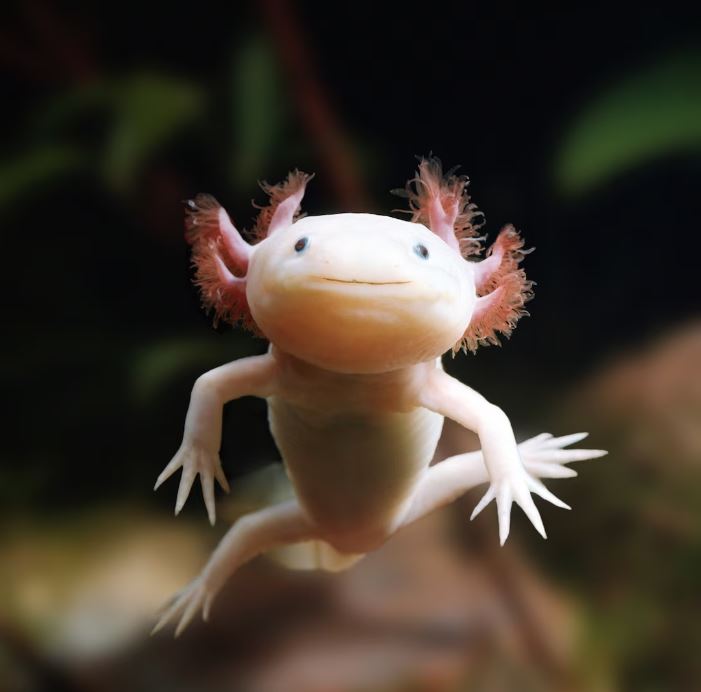


 3:47:6
3:47:6  2023-09-09
2023-09-09  911
911

These Mexican amphibians are impressive enough on their own, with the ability to regenerate lost limbs and stay “young” throughout their lives. Unlike other salamanders that undergo metamorphosis, axolotls (pronounced ACK-suh-LAH-tuhl) never outgrow their larval, juvenile stage, a phenomenon called neoteny.
Their youthful traits include feathery gills sprouting from their heads like a mane, webbed feet, a dorsal fin that runs down the length of their body, and a tail. Though they keep their gills, adult axolotls also have functional lungs and can breathe through their skin. And as if being forever-babies didn’t make them cute enough, their mouths are upturned in a permanent Mona Lisa smile.
Those sweet little smiles can quickly turn into vacuum cleaners when it’s time to eat. Axolotls suck in their prey, which includes crustaceans, mollusks, insect eggs and small fish.
A popular oddity
Axolotls have long fascinated the public, even more so when they were first brought from Mexico to Paris in 1864. Europeans across the continent began breeding the salamanders, the beginning of a robust pet trade in the animals, which breed easily in captivity.
In the wild, they're mostly grayish brown in color. Lighter colored axolotls, especially those with white bodies and pink gills, are usually bred as pets.
Yet in most countries, the species cannot be traded across international borders, in part due to the concern that they'll be poached from the wild. Axolotls are illegal to own in some U.S. states for the same reason.
Yet axolotls are illegal to own in some U.S. states due in part to the risk of them escaping captivity and interbreeding with native salamanders.
Axolotls are also a common research subject for biologists, thanks to their capacity to regenerate lost or damaged limbs, hearts, spinal cords, and even parts of their brains—all without permanent scarring.
Since scarring prevents tissue from regenerating, finding out how and why axolotls don't scar could unlock human's ability to regenerate tissue. An April 2021 study, for instance, deciphered how the axolotl's molecules communicate to promote regeneration.
Despite their ubiquitous captive population, wild axolotls are critically endangered. The amphibians once inhabited the high-altitude lakes around Mexico City, but habitat degradation has limited them to only in a few inland canals in the area. (Learn how Mexican nuns are helping save axolotls.)
Reproduction
Axolotls, which are solitary creatures, reach sexual maturity at a year old, and their spawning season in the wild is in February. Males seek out females, possibly using pheromones, and perform a courtship "hula" dance, shaking his tail and lower body. She responds by nudging him with her snout.
The male then deposits spermatophores, or sperm packets, on the lake floor, which the female picks up with her cloaca, a body cavity, which then fertilizes her eggs.
Females can lay up to a thousand eggs (though the average is about 300) on plant material or rocks, which protects them from predators. After two weeks they hatch and, with no parental care, the larvae are off and swimming on their own.
There's a theory for why axolotls don't change appearance as adults. Because their native lakes never dry up, as is the case for many other water bodies, axolotls didn't have to trade in their aquatic traits-such as a tadpole-like tail-for terrestrial ones, such as legs.
Reality Of Islam |
|

"It is

The process

Astronomers

Cosmologist
 9:3:43
9:3:43
 2018-11-05
2018-11-05
10 benefits of Marriage in Islam
 7:5:22
7:5:22
 2019-04-08
2019-04-08
benefits of reciting surat yunus, hud &
 9:45:7
9:45:7
 2018-12-24
2018-12-24
advantages & disadvantages of divorce
 11:35:12
11:35:12
 2018-06-10
2018-06-10
 6:0:51
6:0:51
 2018-10-16
2018-10-16
 11:34:48
11:34:48
 2022-06-29
2022-06-29
 7:6:7
7:6:7
 2022-03-21
2022-03-21
 2:2:13
2:2:13
 2022-10-08
2022-10-08
 8:25:12
8:25:12
 2022-03-09
2022-03-09
 10:47:11
10:47:11
 2022-11-22
2022-11-22
 1:38:41
1:38:41
 2021-12-08
2021-12-08
 7:45:39
7:45:39
 2018-06-21
2018-06-21
 5:41:46
5:41:46
 2023-03-18
2023-03-18
| LATEST |